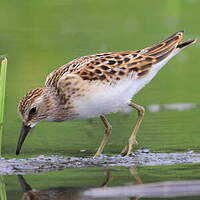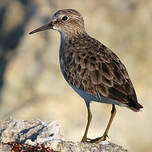Least Sandpiper
Calidris minutilla - Bécasseau minuscule
Identification
The Least Sandpiper is the smallest shorebird in the world. Its short, finer bill is very slightly curved at the tip. It has yellow-green legs that are very short. In the breeding season its bifid eyebrow is difficult to distinguish, its black lores reaching the bill while its dark crown is separated by a white forehead. The scapulars and tertials have a dark center with a fine reddish edging and a gray tip. The chest is light brown striped with black and the lower parts are white. In winter plumage, the scapulars have a thick dark rachial streak merging with the gray-brown edging. The gray-brown chest then has more diffuse streaks. Juveniles can be identified by a white V on the mantle and scapulars and tertials that are bordered with red and white. The whitish eyebrows are clearly visible.
Subspecific information monotypic species
Foreign names
- Bécasseau minuscule,
- Correlimos menudillo,
- pilrito-anão,
- Wiesenstrandläufer,
- törpepartfutó,
- Kleinste Strandloper,
- Gambecchio americano,
- dvärgsnäppa,
- Pygmésnipe,
- pobrežník najmenší,
- jespák drobný,
- Amerikansk Dværgryle,
- amerikansirri,
- territ menut canadenc,
- Mærutíta,
- biegus karłowaty,
- mazais trulītis,
- pritlikavi prodnik,
- Песочник-крошка,
- アメリカヒバリシギ,
- 美洲小滨鹬,
- dvärgsnäppa,
- 姬濱鷸,
Voice song and call
Habitat
The Least Sandpiper nests in the south of Alaska and in all the subarctic regions of Canada where it frequents the peat bogs filled with grasses and sedges, the marshlands dotted with tufts of grass, and sometimes higher up and drier areas with low plants.
Behaviour character trait
The bird is gregarious. To feed, the Least Sandpiper adopts a crouching position. However, when wading in shallow water it holds its body upright, making it appear bigger than it really is. Least Sandpipers are generally monogamous and loyal to their nesting sites. It defends its territory and can be heard during courtship. Compared to other wading birds, it can be easily approached by humans.
Flight
Dietfeeding habits
Reproduction nesting
The male arrives on the nesting site usually one week before the female, in order to delimit its territory.
The couple takes part in building the nest. The male starts its elaboration and the female finishes it. The nest consists of a small depression in the ground lined with dry leaves, grass and moss. It is usually hidden in the vegetation. The female lays between 3 and 4 eggs, measuring 29 x 21 mm, oval, smooth, cream-colored, tinged with green, buff or pink, finely decorated with brown and purple spots. For a little more than twenty days, both parents will brood the eggs in turn. Once the eggs hatch, the chicks will quickly follow the parents to be fed. The chicks feed themselves. It is barely fifteen days after hatching that the young will take flight. Nevertheless, they will become independent only after three weeks.Geographic range
Threats - protection
Sources of information
- IOC World Bird List (v15.1), Gill, F and D Donsker (Eds). 2025-12-07.
- Guide des limicoles d'Europe, d'Asie et d'Amérique du Nord, D. Taylor
- Guide des oiseaux de France et d'Europe, Roger Tory Peterson, Guy Mountfort, P. A. D (Phill
Other sources of interest
 Specification sheet created on
03/08/2023 by Jean-Pierre Trouillas
Specification sheet created on
03/08/2023 by Jean-Pierre TrouillasTranslation by AI Oiseaux.net
© 1996-2025 Oiseaux.net
- Accipitriformes
- Aegotheliformes
- Anseriformes
- Apodiformes
- Apterygiformes
- Bucerotiformes
- Caprimulgiformes
- Cariamiformes
- Casuariiformes
- Charadriiformes
- Ciconiiformes
- Coliiformes
- Columbiformes
- Coraciiformes
- Cuculiformes
- Eurypygiformes
- Falconiformes
- Galliformes
- Gaviiformes
- Gruiformes
- Leptosomiformes
- Mesitornithiformes
- Musophagiformes
- Nyctibiiformes
- Opisthocomiformes
- Otidiformes
- Passeriformes
- Pelecaniformes
- Phaethontiformes
- Phoenicopteriformes
- Piciformes
- Podargiformes
- Podicipediformes
- Procellariiformes
- Psittaciformes
- Pterocliformes
- Rheiformes
- Sphenisciformes
- Steatornithiformes
- Strigiformes
- Struthioniformes
- Suliformes
- Tinamiformes
- Trogoniformes






























